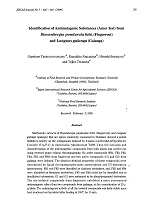Methanolic extracts of Boesenbergia pandurata Schl. (fingerroot) and Languas galanga (galanga) that are spices commonly consumed in Thailand, showed a potent inhibitory activity on the mutagenesis induced by 3-amino-1,4-dimethyl-5H-pyrido [ 4,3-b ] indole (Trp-P-1) in Salmonella typhimurium TA98. Then the isolation and characterization of the antimutagenic compounds from both plants was carried out using reversed phase column chromatography. Six active compounds (FR1, FR2, FR3, FR4, FR5 and FR6) from fingerroot and two active compounds (G1 and G2) from galanga were isolated. The physico-chemical properties of these compounds were determined by liquid chromatography-mass spectrometry and UV-absorption spectrometry. FR1 and FR3 were identified as chalcone derivatives, and, FR2 and FR4 were identified as flavanone derivatives. FR5 and FR6 could not be identified due to insufficient information. G1 and G2 were estimated to be phenylpropanoid derivatives. The six isolated compounds from fingerroot exhibited a more pronounced antimutagenic effect than two compounds from galanga, at the concentration of 25 μg/plate. The antimutagenic activity of all the isolated compounds was fairly stable upon heat treatment and persisted after heating at 105℃ for 15 min.

